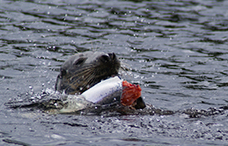SASWG Activites
To date, the Group has investigated
- Processes that seem most effective in reducing seal damage – for example, properly tensioned nets, removal of any dead fish, use of seal blinds, use and maintenance of Acoustic Deterrent Devices and husbandry techniques.
- Differences in damage levels between farm sites, suggesting that sites that are closest to seal haul out sites are no more liable to seal damage than those further from haul out sites, – and that peak damage typically occurs at around month ten of the production cycle.
- Why and how seal attacks occur, noting typical bite types suggest attacks from below – possibly indicating that the bottom of nets are a weak point and that contrary to previous speculation, seals are not targeting salmon livers, but more likely the easiest part of the fish they can reach.
- www.smru.st-and.ac.uk
- Whether declines in common seal numbers are linked to the proximity of their haul-outs to salmon farm sites. Research indicates that overall, such proximity has no influence on increases or decreases in common seal numbers.
- www.sarf.org.uk
The Group will pool knowledge gained, consult with external experts to learn more about how, when and why seals predate on fish pens – and encourage further research where it can be most effective.
Research
The Group is supporting and promoting:
- The development of a prototype testing device to measure source level (output) volume for each transducer, to ensure that Acoustic Deterrent Devices are fully functional according to manufacturer specifications
- Trials to determine if low intensity electric fields have the potential to act as seal deterrents – an initial project was funded by SARF. www.sarf.org.uk
- New acoustic devices that offer a significant reduction in the total amount of sound energy emitted, compared to conventional Acoustic Deterrent devices. In trials such devices have proven effective in discouraging seals, whilst the possibility of causing hearing damage in seals or collateral damage to other wildlife appears to be minimised. www.scotland.gov.uk
- Analysis of the Seal Mammal Research Unit (SMRU) data on seal distribution, together with industry data on seal damage levels, under contact to the Scottish Government. www.smru.st-and.ac.uk
Engagement
The Group:
- Has pressed for more timely reporting under the Seal Licence scheme and for more information to be collected on the licence returns. Information such as the numbers of fish damaged or killed, whether ADDs were in use, what type was in use, whether they were working correctly, what methods of net tensioning and what cage type was deployed, should all be required as part of the seal licence returns
- Has been in dialogue with Scottish Natural Heritage (SNH) – who now sit on the SASWG in an observer capacity - and the Aquaculture Stewardship Council (ASC), with regard to potential restrictions on ADD use in specific areas. SNH and ASC have concerns about disturbance to whales and dolphins – also European protected species - under the Habitats Regulations 1994 (as amended in Scotland). There is concern that curtailment without alternative methods of seal deterrent in place will result in increased levels of seal shooting. Dialogue continues on this subject
- Has raised concerns over the lack of clarity in the wording of the Marine (Scotland) Act 2010 that might imply that a seal can be shot under licence on fish health and welfare grounds alone and without any seal attack on the fish taking place
- Is currently assessing what critical information is required to be reported each time a seal is shot - and how best to encourage the collation of that information
- Has engaged with manufacturers of Acoustic Deterrent Devices to ensure that systems are in place to check that such devices are functioning correctly, as faulty devices can go unnoticed and increase the risk of seal damage and the risk of shooting. Several manufacturers have responded with new designs.


